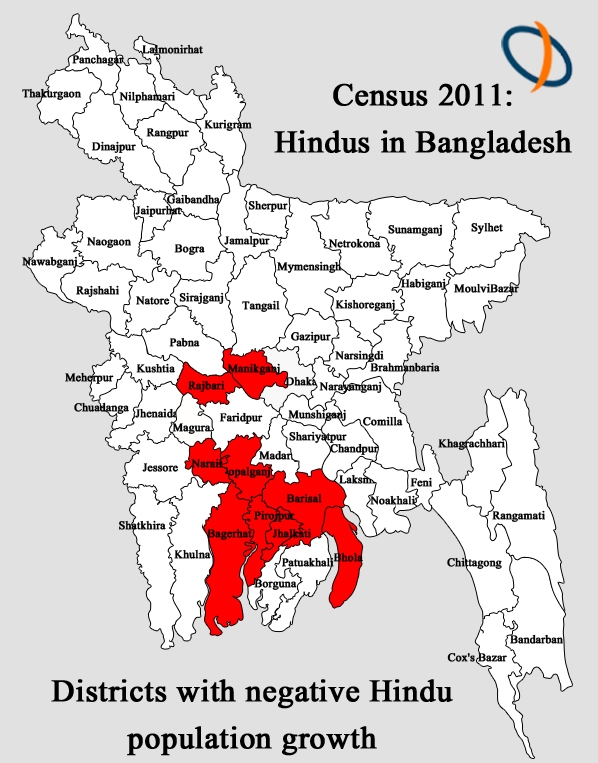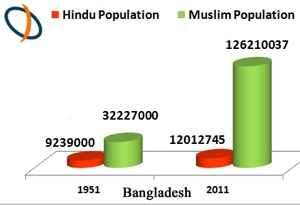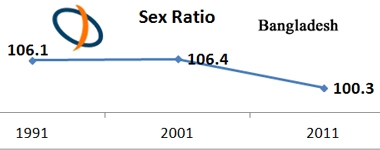The Hindus are slowly but irreversibly moving towards extinction in Bangladesh. That is the inevitable conclusion of Bangladesh Census 2011. It is a slow and silent death of a community which has no strong global forum to raise voice against the threat to their very existence. Whatever may be the reasons, the fact remains, highlighted by hard figures that there is no strong voice for Bangladesh Hindus on any forum including UN. That is why the census 2011 religion data available on Bangladesh government’s website since 2013 has gone almost unnoticed.
The revelations of Census 2011: Writing on the wall for Hindus
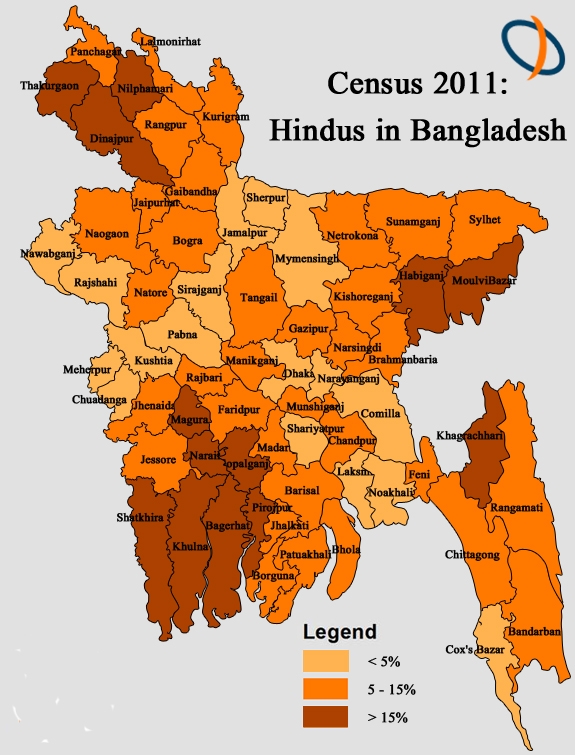
Hindus now remain just over 8.6 percent in Bangladesh. In every decade since 1951 the percentage of Hindus has declined. This decline is without exception in all districts of Bangladesh.
More over in 9 districts the Hindus have registered a negative growth as compared to 2001 Census which indicates a drastic reduction in Hindu population in this near-contiguous cluster.
In terms of absolute numbers, the ‘Vanishing Hindu’ phenomenon becomes clearer. In 1951, the first Census after Bangladesh came in to existence [as East Pakistan at that time], Muslim population was 3 Crore 22 lakh [32 million] while Hindu population was 92 lakh 39000 [9 million]. After 60 years Muslim population is now 12 Crore 62 lakh [120 million] while Hindu population stands at just 1 Crore 20 lakh [12 million] people.
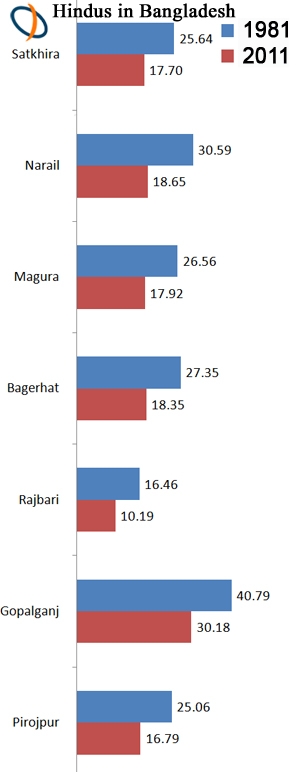
Since 1981, in 7 districts there has been more than 6 percentage point reduction in Hindu population. Considering the statistical parameters like population growth rate and fertility rate etc, many social scientists have predicted that in last half century at least 40 to 80 lakh [4 to 8 million] Hindus have ‘vanished’ from Bangladesh. Dipen Bhattacharya, originally from Bangladesh and now a scientist in USA, predicts in his article ‘The Statistical Future of Bangladeshi Hindus’ that By the end of this Century, Bangladesh Hindus will remain a dismal 1.5%. The average Hindu population growth rate during 2011-2051 would be -0.64% and in 2051 its number will match those of 1974.
Along with Hindus, Buddhist population is also reducing in alarming manner. Buddhist people are concentrated in the Chitgong hill tract comprising of three districts Bandarban, Khagrachhari and Rangamati. In last three decades a large number of tribal Buddhist people have been displaced from the belt.
Some people have tried to attribute this ‘vanishing Hindu’ phenomenon to willing and voluntary migration of Hindus in search of better opportunities. However considering the fact that the Muslims have also migrated in greater numbers and in almost equal proportion to Hindus this reduction in Hindu percentage cannot be explained. Census 2011 gives a vital indication in this regard.
In 2011 Census the sex ratio has fallen by almost 6% as compared to 2001. This indicates a difference of about 40 lakh people [4 million] (fewer male than 2001 - or more female which is unlikely). Since this difference is across the religions it is a logical conclusion that Muslims are migrating in equal proportion to Hindus.
It is obvious that there should be more reasons for the ‘Vanishing Hindus’ phenomenon. Various studies and news report indicate that atrocities, conversions and land grabbing are the main reasons behind the phenomenon.
Atrocities on Hindus: After all the words are spent, what remains behind is the shame.
In multiple incidents repeated over the years Hindus have been attacked, Hindu properties have been looted; houses burnt to ashes, temples were desecrated and set on fire. The causes have been flimsy. In 2013, the international crime tribunal sentenced Delwar Hussain, the vice president of Jamaat -e islami, to death for war crimes of 1971. As a reaction, cadre of Jamaat – e - islami made wide spread loot and arson of Hindu people and properties. In 2012, at Ramu in cox’s bazaar district, the fanatics destroyed 22 Buddhist temples and destroyed many houses as a reaction to some facebook post. To quote Afsan Chowdhury, a noted intellectual of Bangladesh
It was something far more than shameful as several hundred mullahs, probably supported by the Jamaat-e-Islami attacked Buddhist shrines and homes and vandalised those because of an alleged anti-Islamic photo in the facebook. It is at these moments that it becomes clear why Muslims are so unpopular in so many parts of the world. Few have taken collective and social barbarism to such heights even as they claim to be mistreated.
In 2013 elections and post election frenzy, Hindus were targeted and brutally pressurized by various political parties.
Men kidnap and marry 10 to 16-year-old girls from minority communities by forcing them to sign declarations that they are adults and wish to convert to Islam.
Thus a vicious cycle has been set where Hindus migrate to avoid persecution, leaving the rest of the Hindus in reduced numbers and more vulnerable to attacks. Ali Riaz, a political scientist and professor from Bangladesh who is now in USA has concluded in his book ‘God Willing: The Politics of Islamism in Bangladesh’ that in last 25 years about 53 lakh [5.3 million] Hindus have migrated from Bangladesh.
Growth of Communal politics: Hindus! Get lost!
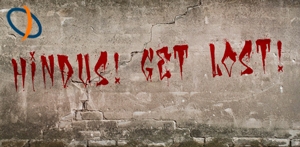
The political atmosphere of Bangladesh is taking more and more communal turn over the years. The word secularism was deleted from the constitution in 1977. Islam was declared as state religion in 1988. The rise of communal political parties in last decade like Jamaat- e- Islami has further vitiated the atmosphere. As a result there are only 15 Hindu members of parliament today out of 350. Generally Awami league was considered as a party accommodative of minorities. Even today out of 15 Hindu members of parliament, 13 are from Awami league and two are independent. All other parties together have zero representation of Hindu members. It should be noted that in the cluster of 9 districts where Hindus have been reduced drastically, in 2001 elections the rabid Anti Hindu Jammat –e - islami and BNP alliance won all seats except in Gopalganj district.
The enemy property act: When Government becomes the robber
Another reason which is not so apparent is that in last so many decades the Hindus have lost their properties due to the unfair provisions and biased implementation of the so called Enemy property act or vested property act. Abul Barkat, an economist and professor of Dhaka University, through his in-depth studies ‘Political Economy of Vested Property Act in Rural Bangladesh’ and ‘An Inquiry into Causes and Consequences of Deprivation of Hindu Minorities in Bangladesh through the Vested Property Act’ has exposed the devastating effect this act and its many versions over the period has on Hindus in Bangladesh. According to his study
43% of Hindu households which comes to about 12 lakh [1.2 million] families have been affected by the EPA or VPA. Total land acquired under this act is about 20 lakh Acres [2 million] which is 5% of total Bangladesh land but it is almost 45% of land owned by Hindu community.
The study has also documented the land grabbing techniques. Death of one family member or migration of one family member is used as an excuse to enlist and grab the entire property of the family. There are many instances where Influential parties have grabbed the land by using violence, local thugs, and forged documents. For example an investigation by ‘Jugantor’ in 2009 revealed that of the 30000 Acres of land appropriated by Chitgong administration as ‘vested property’ only 5000 Acres is in Government control. The rest is in possession of ‘unknown elements’. As a specific example ‘The daily star’ news report amply illustrates the reality. To quote from the news report The unyielding use of violence and power by local elites and land administrators feature frequently in case stories of vested law. When Shamaresh Nath from Shirajdikha, Munshiganj challenged the declaration of 134 decimal of his homestead property as vested, the Union Nirbahi Officer (UNO) of the area physically harassed him, violently beating his family members with goons and the police. Even though High Court ruled in Nath's favour in 2009, the UNO continues to deny him access to his land, threatening to harm Nath and his family if they don't back off. Nath has not been able to return home even today. He says, “My father was the District Commissioner of Bangladesh. If he can't get justice, where will ordinary people go?”
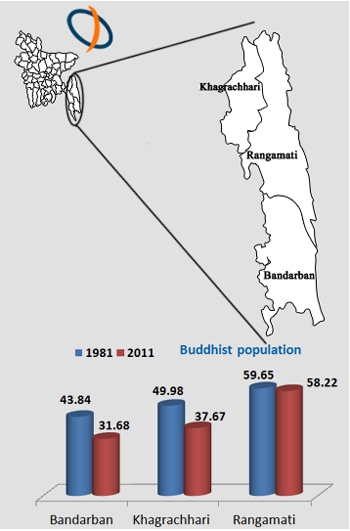
Followers of Buddhism have faced a similar fate. The study of Abul Barkat highlights that In Chitgong Hill tracts which includes three districts Rangamati, Bandarban and Khagrachhari, 22 % Buddhist people have been driven out of their households. Their traditional social ownership of land has come down from 83 % in 1978 to 41 % in 2009 thus essentially making them landless.
Looking at this stupendous land grab it is not at all surprising that when almost half the Hindu population is deprived of their property, they are forced to migrate out of Bangladesh.
Not all Bangladeshi are happy about it. To quote Afsan Chowdhury again
After all the words are spent, what remains behind is the shame. We have allowed this to happen again and again…We didn’t need a new version of old Pakistan. Bangladesh was to be the exact opposite but thanks to inefficiency, corruption, bigotry and religious excess, we have failed to build a state we could be proud of. For us there is only disgust. On behalf of all who accept what we have said, our sincerest and humblest apology to the people who have suffered in particular and to all minorities in general.
It is a ray of hope that there are some Bangladeshi citizens who are genuinely concerned. Whether it is sufficient to change the fate of Hindus is another matter. The world has seen how Jews acting as a strong lobby in international politics have achieved the security of Jewish community worldwide and garnered support for Israel on various global platforms. Christians are less than 3% in India according to Census. But in last few months they have been able to mobilize the support of USA and other world powers against the perceived and imagined threat to them even in the absence of concrete instances. Hindus on the other hand, even counting the RSS VHP global network of Hindus, are nowhere near to mobilize a global opinion and pressure in support of Bangladesh Hindus. India, which should be the natural support base for Hindus anywhere in the world, prefers to remain mute on such subjects. Perhaps the Indian politicians fear to lose their precious secular tag if they talk about Hindus. On this background the question looms large and real, are Bangladesh Hindus on the way to slow but sure annihilation?


